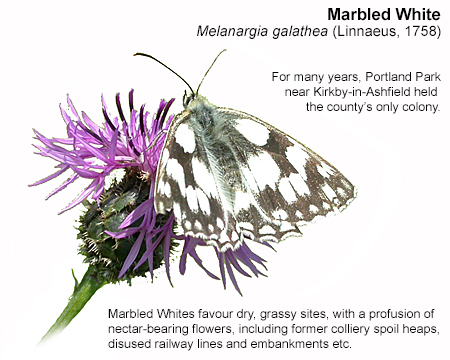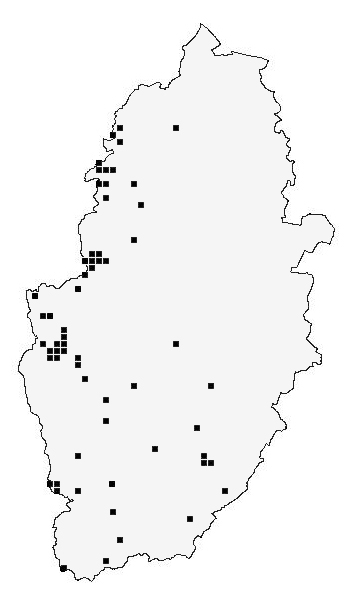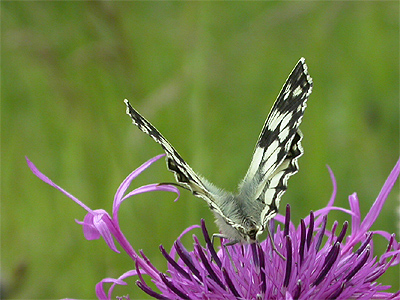

| The Marbled White in Nottinghamshire |
| .... |
| The existence of the Marbled White
in Nottinghamshire has been well known since the early
1990's and the colony's precise location at Portland
Park, was originally publicised in the much missed
Nottinghamshire Naturalist Vol 2, Issue 4, Aug 1999. We visited the site in July 2005 and following the directions given in The Nottinghamshire Naturalist, eventually found the colony in the old quarry workings area. This was quite well away from where it was originally mentioned, but the Marbled White was indeed present - and in good numbers too. For many years, Portland Park (situated between Kirkby-in-Ashfield and Annesley at SK499551) held Nottinghamshire's only Marbled White colony. But in recent years, this delightful butterfly has increased its local and national range and has also been successfully introduced at a number of other sites. Historical records and a recent range expansion |
 |
|
| .... | ||
| Based on the records in Carr's 1916 book 'The Invertebrate Fauna of Nottinghamshire' published by J.& H. Bell Ltd, Nottingham, the Marbled White was always omething of a rarity in Nottinghamshire. Carr begins his summary of the species with 'very rare and not seen for some years, but it is always possible that so extremely local an insect may persist in some out-of-the-way locality'. Carr later states that ' according to Brameld, it used to be common at Kirton near Tuxford, at Warsop and near Mansfield; and Gascoyne found it 'in one field at Egmanton near Tuxford in profusion'. Leivers had two specimens in his collection, taken near Bingham in 1890. | ||
| .... | ||
 |
On the basis of the lack of records from any single site over a number of years listed by Carr, it seems unlikely that the Marbled White was ever a breeding species in Nottinghamshire until fairly recently. It favours dry, grassy sites, with a profusion of nectar-bearing flowers, including former colliery spoil heaps, disused railway lines and embankments etc. Most of the county's successful introductions/colonies, are situated on the strip of Magnesium Limestone running up the western side of Nottinghamshire, near to its border with neighbouring Derbyshire. In the south of the county, the Marbled White tends to be more sporadic in occurrence, suggesting a more natural (and perhaps largely unsuccessful) range expansion into the county from the south. But the Marbled White's range expansion in Nottinghamshire, did coincide with a national north and easterly expansion. In Nottinghamshire, it has occurred (or is still present) at Netherfield Lagoons, Portland Park, Warsop Main Pit Top, Hills and Holes at Market Warsop, Dyscarr Wood, Toton Sidings, Bingham Linear Park, Langar Wildflower Farm, Worksop Manor, Freckland Wood (Newstead) Shirebrook Pit Wood, Shireoaks Pit Top and Attenborough NR, but there are many more sites where it is either present, or has been reported from. Marbled White and captive-bred releasesDisused Colliery railway lines have certainly been an aid for the Marbled White to spread and colonise new sites, but it has also been helped by a number of unofficial releases of captive-bred stock, which certainly includes the Hills and Holes colony and probably several others in the Mansfield and Worksop area. This colony has been present in an ungrazed section of the site since 2012, when we counted 50 adults during one visit in the July of that year. Word of the Marbled White's occurrence soon got out locally and there was a steady number of local people who visited the site, specifically to see and photograph them. In Market Warsop at least, the release of this butterfly generated much interest and certainly encouraged more people to visit the site than would have done normally. Was the release such a bad thing? At this point, some people may already be saying yes it was. |
|
| .... | ||
| Opinions on unofficial releases of
native butterflies vary and the person responsible for some Marbled
White releases is well known in butterfly circles and has often been
vilified for his actions. However, there are other people releasing
captive-bred butterflies in Nottinghamshire. Whether you agree with the release or re-introduction of butterflies is a matter of personal choice and regarding the release of non-native species, it is clearly wrong and we would not agree with such releases. Martin White's regular releases of good quality, captive stock was not just a matter of throwing butterflies aimlessly from a car window. The sites chosen were carefully selected on habitat and suitability for the particular species to be released, or where that species was historically known to have previously occurred. Breeding butterflies is not easy and indeed, some species are notoriously difficult to breed. In our view, the conservation organisations missed out by not employing Martin's obvious talent and skill as a breeder of butterflies. |
 |
|
| .... | ||
|
Not relevant to Nottinghamshire we know, but maybe the UK's Large Blue could have been saved, rather than us have to use continental stock to reintroduce it back in to the UK. Martin once told us that he would have liked to have been given the opportunity and he may well have suceeded, but after his recent death, its something we will never know. But however some colonies appear, it shouldn't lessen the value of having Marbled Whites and other species such as the Purple Emperor successfully re-established in the county. As a grass feeding species, there is certainly no danger of Marbled Whites being detrimental to any of the other butterflies found on site. Many butterflies have done well over the past number of years, perhaps better than some media reporting and press releases would suggest. So although we know that some Marbled White colonies in Nottinghamshire are introduced, this is one butterfly which has also arrived here naturally. Things aren't all bad. |
||
| Butterflies |
| Homepage |